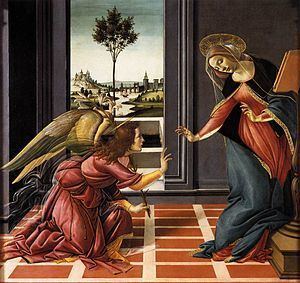Year 1489 Location Uffizi, Florence Period Early renaissance Subject Annunciation | Medium Tempera on panel Artist Sandro Botticelli Created 1489–1490 | |
 | ||
Dimensions 150 cm × 156 cm (59 in × 61 in) Genres Pastoral, Christian art, History painting Similar Sandro Botticelli artwork, Early renaissance artwork, Christian art | ||
Art for advent 2015 the annunciation and incarnational humanism
The Annunciation, also known as the Cestello Annunciation, is a tempera painting created in 1489 by the Italian Renaissance master Sandro Botticelli. It is housed in the Uffizi Gallery of Florence and has been part of the collection since 1872.
The picture was commissioned in May 1489 to decorate the chapel of the Florentine monastery Cestello, which is now known as Santa Maria Maddalena de'Pazzi.
The subject of the painting is the Annunciation, in which the angel Gabriel visits the Virgin Mary to tell her that she has been divinely impregnated and will bear the Christ child. Underneath the painting on its original frame are words in Latin from St. Luke's Gospel 1:35 "The Holy Ghost shall come upon thee, and the power of the Highest shall overshadow thee."
The subject of the Annunciation is common in Christian art and has been depicted by many artists, in multiple formats, and in different time periods. In addition to the Cestello Annunciation, Botticelli also painted a 1485 Annunciation now in the Metropolitan Museum of Art and a 1495-1500 version now housed in the Kelvingrove Art Gallery and Museum.
